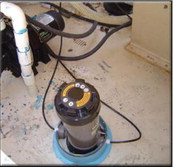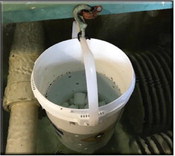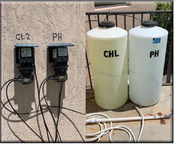A day in the life of a Florida public pool inspector
By Lauren Broom
Cyanuric acid (CYA) is a topic frequently misunderstood by pool service techs. There is a lack of understanding of what CYA is, how much should be used, and what happens to pool water when it has too much or too little. Service techs also need to understand how to test, regulate and safely remove it from their pools.
In Florida, CYA levels should not exceed 100 ppm in public pools, and 40 ppm in public spas. These levels are mandated in Chapter 64E-9 of the Florida Administrative Code (FAC) and are checked semi-annually by the state pool inspector.
The recommended level of CYA from the Pool & Hot Tub Alliance (PHTA) is 30-50 ppm.
While Florida does not have any minimum CYA level requirements, when CYA levels exceed 100 ppm for a pool and 40 ppm for a spa, the inspection will come back as unsatisfactory.
The Florida Department of Health (FLDOH) will have to reinspect the pool or spa 30 days from the initial date, to verify that CYA levels are below the 100 and 40 ppm levels.
Furthermore, regulation of a public spa in Florida places restrictions on stabilized chlorine, also known as trichlor or dichlor.
Specifically, a public spa cannot be equipped with an erosion feeder that dispenses tricholor or dichlor, and neither compound can be placed in the skimmer basket or the collector tank. The service tech is also prohibited from hand feeding granular dichlor.
This does not mean that CYA is banned in Florida’s public pools and spas. CYA may be used as long as it cyanuric acid by itself, and not part of a compound.
Instead, a public spa can use an erosion feeder that uses bromine tablets or calcium hypochlorite briquettes. A peristaltic pump such as a Stenner pump, could be used to feed sodium hypochlorite (liquid bleach) as well.
In my experience, I saw pool techs placing trichlor tabs into the skimmer basket or the collector tank. In one instance, a pool tech even drilled holes into a five gallon bucket and suspended it into the collector tank. This particular pool had two trichlor erosion feeders that the tech decided to abandon and replace with the suspended five gallon bucket. Simply put, this was a very poor choice.
It is critical to maintain proper CYA levels. When CYA is above 50 ppm it will increase the risk of recreational water illness outbreaks and algae blooms.
Trichlor tabs in skimmer basket
Lauren Broom
Lauren Broom is a Certified Pool Operator Course, CPO ® , instructor and a former health inspector for the Florida Department of Health. Lauren has a Bachelor of Science Degree in Biology and is a registered sanitarian.
She has 16-years of experience in commercial pool inspections and waterborne disease outbreak investigations.
Lauren lives in Palm Bay, Florida with her husband of 17 years and their 3 children. Lauren can be reached at spacecoastpoolschool@yahoo.com When CYA is below 30 ppm, chlorine becomes less effective and will break down quickly, resulting in little or no sanitizer in the water. The pool service company will need to use more chlorine in the pool to maintain an adequate chlorine level.
As a Florida pool inspector, I have come across many examples of CYA violations in public spas. During one such inspection, the spa had a CYA level over 100 ppm. This spa was built with a bromine erosion disinfection feeder. There were multiple reinspections conducted and the high CYAviolation was still present. The multiple reinspections resulted in many fees that had to be paid by the homeowner’s association (HOA) that owned the property.
Upon the second reinspection, the inspector contacted the pool service company and spoke with them about this violation. They stated that the pool tech was using bromine in the erosion feeder. This complicated the findings because bromine does not contain CYA. The phone call ended without any determination as to how the CYA was in the spa water.
By the time the third inspection was conducted, the inspector learned that the tech was hand feeding granular dichlor shock into the spa; Dichlor is a stabilized form of chlorine that contains CYA. In fact, the tech had been adding dichlor instead of placing bromine tabs into the erosion feeder. At the final reinspection, the HOA representative apologized to the inspectors.
It is essential to understand that stabilized chlorine products — Trichlor and Dichlor — contain CYA. Trichlor tablets, pucks or sticks are introduced into pool water through an erosion feeder. As long as the feeeder is operational, CYA is continuously fed into the water. Dichlor is another variety of stabilized chlorine, and pool techs frequently hand feed the granular form as a shock treatment, and this can contribute to increasing CYA levels.
In Florida, if a pool is built with an erosion feeder, trichlor tabs are necessary. Pool service techs must partially drain the pool and add fresh water to dilute the high CYA concentration levels. Techs further control CYA levels by draining small amounts of water when backwashing or cleaning filters each week; this helps maintain CYA levels below 100 ppm.
In my experience inspecting public pools and spas in Indian River County,
Trichlor erosion feeder Florida, I found many pools and spas exceed the maximum state CYA levels.
I also found that techs had to battle with onsite management about the requirement to partially drain the pool. Frequently service techs would not drain the pool and retain the high CYA levels.
Problems would increase even further due to onsite management’s lack of education, further affecting how the tech managed the pool. Better education for onsite management would be beneficial.
For public pools that are constructed with a peristaltic pump (such as a Stenner pump), sodium hypochlorite, or liquid bleach is used. This chlorine product does not contain CYA. Calcium hypochlorite and lithium hypochlorite also do not contain CYA.
For pools that are sanitized with calcium hypochlorite, lithium hypochlorite, and sodium hypochlorite, service techs need to hand feed granular CYA into the pool water to cause the 30-50 ppm recommended CYA level.
Because there are no minimum CYA requirements in public pools or spas, most pool techs do not think to hand feed granular CYA into the water.
Subsequently, the pool water will not have any cyanuric acid and will result in more chlorine demand. This in turn creates a risk of recreational water illness outbreaks when levels of disinfectant drop below required minimum levels.
Often when I tested pool water, there was no CYA level at all. These public pools were fed by sodium hypochlorite peristaltic pumps and the pool service techs were unaware that they should hand feed some granular CYA into the water to help protect the chlorine.
A few years back there was a draft rule of Chapter 64E-9 of the Florida Administrative Code (FAC), that would have required the level of CYA to be maintained at 40 ppm or below for both public pools and spas.
This requirement was not included in the 2016 Florida rule update. Instead, the 2016 code added that it is recommended to keep CYA levels below 40 ppm on a public pool.
This maximum level of CYA was already required in public spas.
In conclusion, pool techs need to know the following: • CYA is necessary to properly maintain pools and spas.
• Pool techs will have difficulty maintaining pools and spas with either high or low levels of CYA.
• Both Trichlor and Dichlor contain CYA.
• Constantly using Trichlor and/or Dichlor will increase CYA levels.
• Service techs should regularly check CYA levels to maintain 30-50 ppm.
• It may be necessary to periodically drain pools and spas to maintain the recommended CYA level.
• Pool techs should educate pool owners and HOA members to advise them of the importance of proper CYA levels.
Five gallon bucket with drilled holes with trichlor tablets in collector tank
Peristaltic pump-Stenner pump setup



